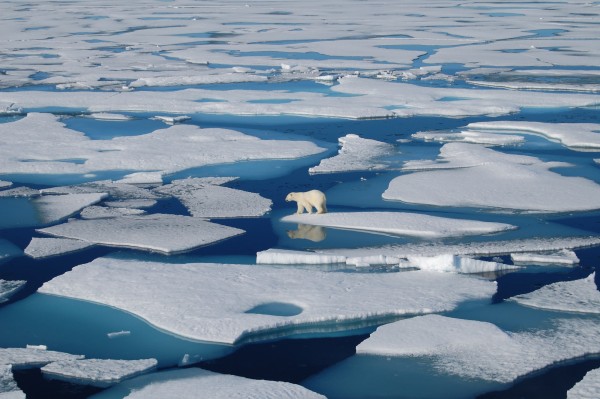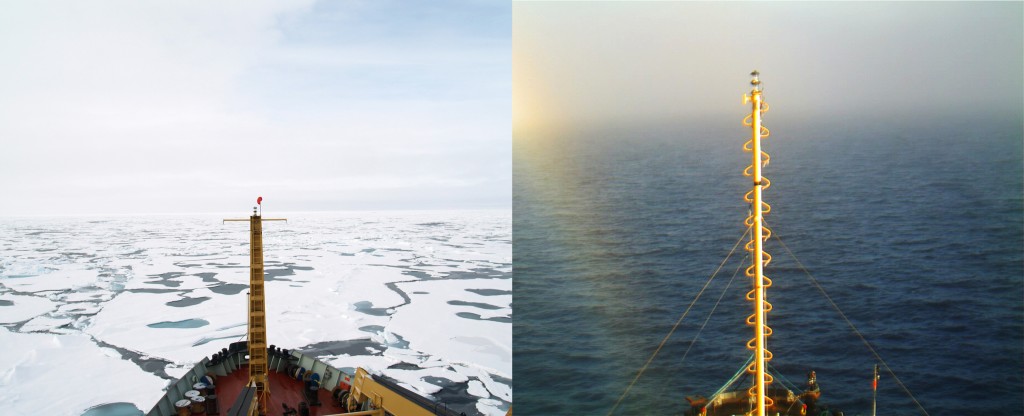Study reveals how Arctic Ocean drives ice melt
March 2, 2016
Yuri Bult-Ito
907-474-2462
Unprecedented ice melt in the Arctic Ocean is not caused by warming air alone, according
to a recent study that emerged from a workshop at the University of Alaska Fairbanks.
Sea ice in the Arctic has continued to get thinner and smaller and to move faster
during the past two decades.

Examining a collection of observational data obtained for more than two decades, a
group of more than two dozen international researchers gathered at the March 2013
workshop to tackle the question of whether the increasing warmth of the Arctic Ocean
itself is melting its own cover of ice.
The results were published in December in the Bulletin of the American Meteorological
Society.
Researchers investigated how the effects of ocean currents, salinity, wind and ice
interact with one another to accelerate sea ice melting. They showed that small changes
in ways the ocean transports heat to the ice cover could have a substantial impact
on future changes in Arctic ice cover.
“Sea ice loss has implications for governance, economics, security and global weather,
so it is critical to understand how ocean, ice and air interact,” said Igor Polyakov
of the UAF International Arctic Research Center, who was one of the lead authors of
the study.
The Atlantic and Pacific Oceans are heating up and warmer currents are flowing into
the Arctic Ocean. The heat from these currents would melt the Arctic sea ice instantly,
Polyakov said, but so far it hasn’t happened because the warm currents don’t come
into direct contact with the ice.

“The reason is these currents are saltier, therefore heavier, so they sink deeper
into the ocean. Colder, fresher surface water partly shields the ice on the surface
from warm water below,” he said.
Wind and faster-moving ice floes stir the ocean below, causing cold surface water
and warm waters below to mix. As they are mixed, warmer water is brought to the surface
and melts the ice cover from beneath it.
As this process continues, more sea ice melts.
The heat from the sun not only directly melts the sea ice but also heats up the water
between ice floes, which is darker than ice and absorbs more heat. The heat from the
sun also penetrates the thin areas of the ice, causing them to break from bigger,
solid masses of ice. These smaller ice floes move freely.
Fresh water rushing from the large Siberian and North American rivers add more warm
water to the ocean and accelerate ice melt, according to the paper.

The Arctic is warming faster than any other region on the planet.
“Sea ice melt in the Arctic is one of the most visible indicators of global climate
change,” said Peter Winsor of the UAF Institute of Marine Science, who contributed
to the study.
The study presents the most comprehensive summary so far of the current understanding
of how heat reaches the ice base from the original sources, such as currents from
different oceans and river discharge. The study gives key directions for creating more
realistic future projections of the warmer and more dynamic “new Arctic.”
“Physical mechanisms within the Arctic Ocean impact biological, chemical, geological
and physical processes and occur across sovereign state boundaries,” noted Polyakov. “So
it is really important that we make multidisciplinary, multiagency and multinational
efforts to reduce uncertainties in the projections of the future Arctic.”
The Chapman Chair Untersteiner Workshop was hosted by the UAF College of Natural Science and Mathematics and the International Arctic Research Center at UAF.
ADDITIONAL CONTACT: Igor Polyakov, UAF International Arctic Research Center, 907-474-2686, igor@iarc.uaf.edu.
ON THE WEB: The paper, entitled “Toward quantifying the increasing role of oceanic heat in sea ice loss in the New
Arctic,” was published in the Bulletin of the American Meteorological Society. Learn more
about An Untersteiner Workshop: On the Role and Consequences of Ocean Heat Flux in Sea Ice
Melt.


